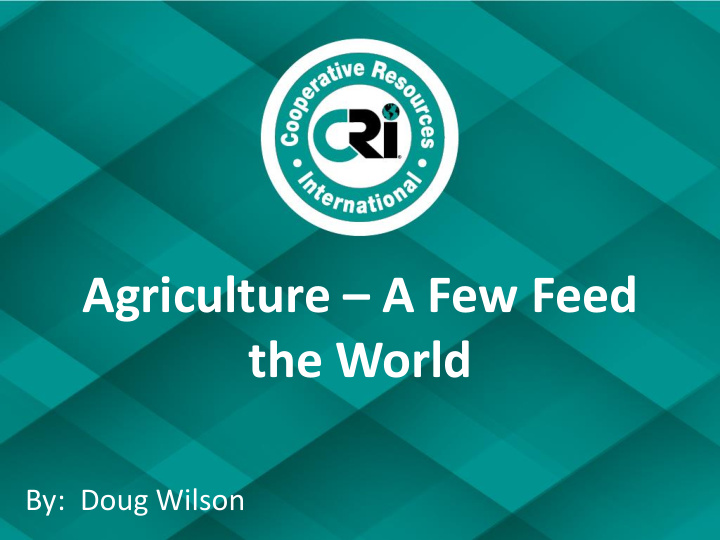



Agriculture – A Few Feed the World By: Doug Wilson
Cooperative Resources International
Size and Scope International Marketing Finance Human Resources Information & PR Business Development Information Technology
29 CRI Locations – Shawano, Wis. – Ellsworth, Iowa – Guelph, Ontario – Verona, Wis. – Lincoln, Neb. – Ingersoll, Ontario – Bonduel, Wis. – Umatilla, Ore. – Cape Town, South Africa – Marshfield, Wis. – Billings, Mont. – Cardiff, Wales – Menomonie, Wis. – Strafford, Mo. – Sao Carlos, Brazil – Mount Horeb, Wis. – Tiffin, Ohio – Mexico City, Mexico – Melrose, Minn. – Ithaca, N.Y. – Santiago de Querétaro, – South St. Paul, Minn. Qro, Mexico – West Fargo, N.D. – Rock Creek, Minn. – Zieuwent, Netherlands – Mitchell, S.D . – Zumbrota, Minn. – Albany, Minn. – Montgomery, Minn.
Annual Revenue 1994 - 2015
CRI Values • Innovation • Integrity • Leadership • Quality • Stewardship
Stony Hill Bull housing and GENESIS Genex Shawano, Wis. Shawano, Wis. CRI Headquarters Shawano, Wisconsin Bull and heifer housing Bull housing Tiffin, Ohio Ithaca, New York
MOFA Global ICB
AgSource
CLA
Governance Structure AgSource Genex 3,916 11,902 Members Members 75 119 Delegates Delegates Board of Board of Directors = 9 Directors = 13 5 2 CRI Board of Directors 7
CRI Business Model Mission Statement CRI Key CRI Values Performance Areas CRI Annual CRI Strategic Plan of Work Initiatives CRI Strategic Plan
The CRI Culture • Manage change and do not let change manage us. • We will narrow our focus if it broadens our appeal. • We are quick to adopt new technology if appropriate.
Production Ag Trivia Milk Production – 1946 vs. 2016 ► 21% Fewer cows ► 23% Less feed ► 65% Less water ► 90% Less land ► Same milk volume
Production Ag Trivia (Continued) ► Less than 10% of the average household income spent on food ► First week in February earned enough to buy for year ► 30% of the food in the U.S. is wasted ► Food spending equals recreation and two-thirds health costs
Production Ag Trivia (Continued) ► One million or .85% make a living farming ► Another 1.2% have farm income ► 80% of Americans live inside city limits ► Last year 10% of ag income was ag tourism
Mega Trends Impacting Production Ag ► World population moves from 7.0 billion to 9.2 billion by 2050 ► Developed regions stable – developing regions change ► One billion people (1/7 th ) suffer chronic hunger today ► By 2050 must double food production
Mega Trends Impacting Production Ag (Continued) ► 50% world population middle class ► 2050 anticipate 70% ► One billion people move to middle class ► Research indicates when people move from poverty to middle class, protein is the first priority
Mega Trends Impacting Production Ag (Continued) ► Low energy cost impacts ag positively: Directly impacts farm production costs Increases consumer spending power (major debate globally) Increases global speed to middle class in non-energy producing countries
Mega Trends Impacting Production Ag (Continued) ► Extreme low energy cost has a negative impact: Where it has a negative economy impact for developing countries reduce importation American farmers are dependent on exports
Mega Trends Impacting Production Ag (Continued) ► The U.S. cannot consume the difference ► In general, ag commodity lags behind energy price
Resulting Trends ► World food trade will increase as world population increases. Population growth and productive land distribution is not the same. ► Winners are North America, South America, Oceania, and Europe ► Today 25% of all food is globally traded ► Every farmer is a global producer
Resulting Trends (Continued) ► Research and technology is not a choice if we are to feed the world ► Cannot ignore food waste ► Globalization demands production efficiency and technology increases efficiency
Resulting Trends (Continued) ► Globalization means world politics and U.S. trade facilitation policy are very important ► The long-term production ag dynamics is attracting Silicon Valley and outside investment
Resulting Trends (Continued) ► Immigration law is important as farm labor force is dominated by such ► The shortage of four-year ag graduates has created a scenario of high starting wage
Conclusion ► Great time to be in production ag. Few industries promise a 30-year steady growth. ► If we are to effectively compete, we must become global marketers, not just producers of volume ► Production ag provides a great career opportunity for those without ag background
Food production, not weapons, will make strong nations.
Thank You!
Recommend
More recommend